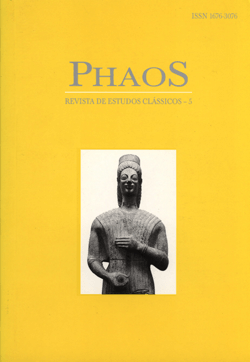Las mimesis aristotélica más allá de los límites de la poética
Palavras-chave:
Aristotle. Mimesis. Art. Nature. Analogy. Supplementation.Resumo
From Renaissance on, Aristotelian mimesis had exerted its influence mainly through the principie that "art imitates nature". This principie was interpreted in different and multiple ways reaching its most categorical rejection with nineteenth-century aestheticism. What is surprising is that this principie was neve r explicitly enunciated in the Poetics as subject of the téchne poietiké, although it is frequently mentioned in different treatises devoted to the study of natural history, e.g. Meteor., Phys., Protr., etc. 1n the first pari of this paper, I present a brief examination of some passages that I believe gives evidence of the analogical value that mimetic vocabulary usually has in Aristotle. Then, in the second part I analyze the different formulations of the principie in the corpus in order to elucidate the complex relation of analogy and supplementation between the sphere of art and that of nature. My attempt contradicts Halliwell's interpretation (1999 & 2002), to whom it is imperative to distinguish the wider uses of the term from the proper artistic signification of mimesis in Aristotle's PoeticsReferências
a) Fuentes:
ARAUJO, M. Y MARIAS, J, trads., AristóteIes. Ética a Nicómaco. Madrid: Centro de Estudios Constitucionales, 1994.
BOERI, M, trad., Aristóteles Física (Libras I-II). Buenos Aires: Biblos, 1993.
DÜRING, Ingemar, ed., Aristotle's Protrepticus. Gotemburg: Acta Universitatis Gothoburgensis, 1961.
ECHANDÍA, G. R., trad., AristóteIes Física. Madrid: Gredos, 1998.
GARCÍA VALDÉS, M., trad., Política. Madrid: Gredos, 1988.
JIMÉNEZ SÁNCHEZ-ESCARICHE, E., trad., Partes de los Animales. Madrid: Gredos, 2000.
LE BONNIEC, H., trad. Pline, rancien, Histoire Naturelle (Livre xxxiv), Paris: Belles Lettres, 1953.
LEE, H.D., ed., Aristotle. Meteorologica. Cambridge, Mass.: Loeb Classical Library, 1951.
PALLÍ BONET, J., trad. Investigación sobre los Animales. Madrid: Gredos, 1992.
PECK, A. L., trad., Aristotle. Generation of Animals. Cambridge, Mass.: Loeb Classical Library, 1953.
PECK, A. L., trad., Aristotle. Parts of Animals, Cambridge, Mass.: Loeb Classical Library, 1961.
RACKHAM, H. trad., Aristotle. Politics. Cambridge, Mass.: Loeb Classical Library, 1944.
ROSS, W. D., ed., Aristotle's Physics. Oxford: Clarendon, 1936.
ROSS, W. D., ed., Aristotle's Politics. Oxford: Oxford University Press, 1957.
TREDENNICK, H. Aristotle. The Metaphysics (Books I - IX), Cambridge, Mass.: Loeb Classical Library, 1956.
b) Literatura Secundaria:
BAUDELAIRE, Charles. Las Flores del Mal, Barcelona: Planeta, 1984.
COPI, Irwing. Introducción a la lógica. Buenos Aires: Eudeba, 1962.
DÜRING, I. 1955. "Aristotle in the Protrepticus” en Masion, A. (ed.) Autour d'Aristote, Louvain.
DÜRlNG, Ingemar. Aristóteles. México: UNAM, 1990.
FEMENÍAS, María Luisa. Inferioridad y Exclusión: Un modelo para desarmar. Buenos Aires: Grupo Editor Latinoamericano, 1996.
GALLO P, David., "Animais in the Poetics” en Oxford Studies of Ancient Philosophy, Oxford, 8, p.145-171, 1990.
GARCIA GUAL, Carlos."Introducción". En PALLI BONET, J., trad., Investigación sobre los Animales, Madrid: Gredos, 1992. P. 7-32.
HALLIWELL, Stephen. The Aesthetics of Mimesis. Ancient Texts and Modern Problems. Princeton: Princeton University Press, 2002.
HALLIWELL, Stephen. "Aristotelian Mimesis Reevaluated". En Gerson, Lloyd. (ed.); Aristotle: Critical Assessments, London: Taylor & Francis, Vol. IV, pp. 313-335.
HAPP, H. Hýle: Studien zum aristotelischen Materie Begrjff. Berlin& New York: Walter de Gruyter, 1971.
JAUSS, H-R. "El arte como anti-naturaleza. El cambio estético después de 1789". En _____. Las transformaciones de lo moderno. Madrid: Visor, 1995. P. 105-134.
LLOYD, G.E.R. Polarity and Analogy. Cambridge, Mass.: Hackett, 1992.
LLOYD, G.E.R. Polaridad y Analogía. Madrid: Taurus, 1987. Capo VI: "El análisis de la argumentación por analogía".
LÓPEZ FARJEAT, L. X. "El silogismo poético y la imaginación en Alfarabi". Tópicos, México, n 18, pp. 97-113.
MCKEON, Richard. "Rethoric and Poetic in the Philosophy of Aristotle". En Olson, E. (ed.) Aristotle's Poetics and English Literature, Chicago: Chicago University Press, 1965. p. 201-236.
MOREAU, Joseph. Aristóteles y su escuela. Buenos Aires: Eudeba, 1972.
OWENS, J. "Teleology of nature in Aristotle". The Monist, 52. 2, pp.l59-173. l968.
PANOFSKY, Erwin. Idea. Contribución a la historia de la teoría del arte, Madrid: Cátedra, 1980.
PERELMAN, CH. y OLBRECHTS-TYTECA, L. The New Rhetoric. A Treatise on Argumentation. Indiana: University of Notre Dame Press, 1971.
SUNOL, Viviana. "El valor analógico de los usos no-artísticos de mimesis en el corpus aristotelicum". La Plata: inédito. 2005. 43p.
SUNOL, Viviana. Aprendizaje y placer mim ético en la Poética de Aristóteles. La Plata: 2004, 68p.
SUNOL, Viviana. Disponible en <http://www.sedici.unlp.edu.ar/sunol.>. (Tesis de Licenciatura, Universidad Nacional de La Plata).
SUNOL, Viviana. Mimesis: una reconsideración de sus orígenes etimológicos y de su signifjcación física en Aristóteles, 2004. Trabajo presentado en Tercer Coloquio Internacional "Ética y Estética. De Grecia a la Modernidad", La Plata: 2004. 1 CD-ROM.
VELOSO, Claudio. W Aristóteles mim ético. San Pablo: Discurso Editorial, 2004.
WILDE, Oscar. "Decadencia de la Mentira" en Intenciones. México: Mono's, 1945.
Downloads
Publicado
Edição
Seção
Licença
Ao se submeterem textos para a PhaoS, seus autores devem estar cientes de que, se aprovados para publicação, a revista terá sobre eles todos os direitos autorais pertinentes. Originais não serão devolvidos.

